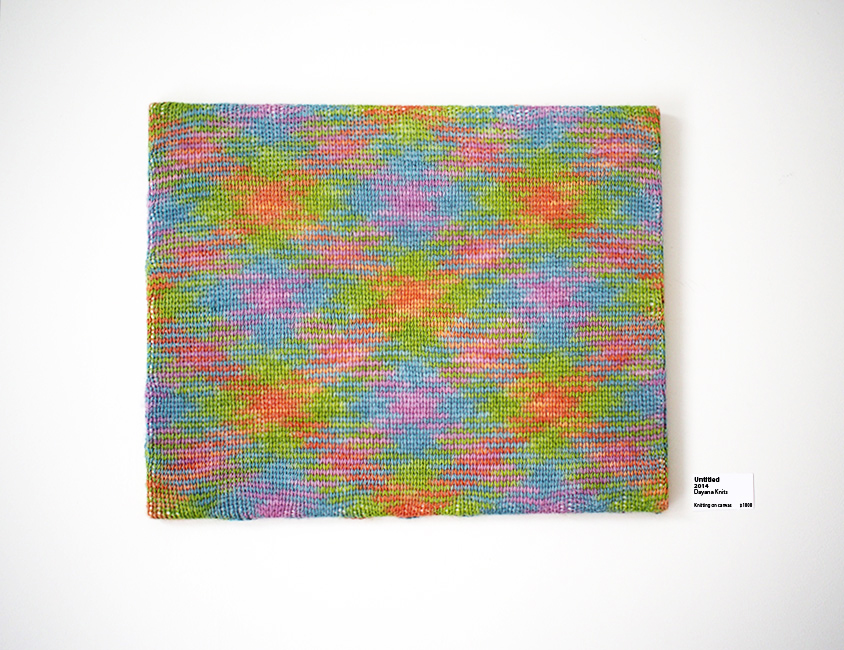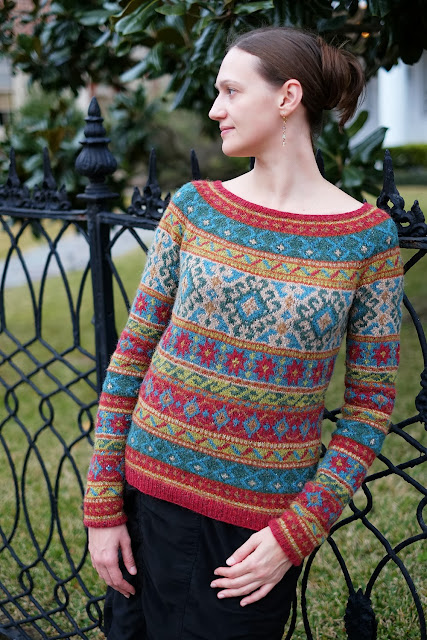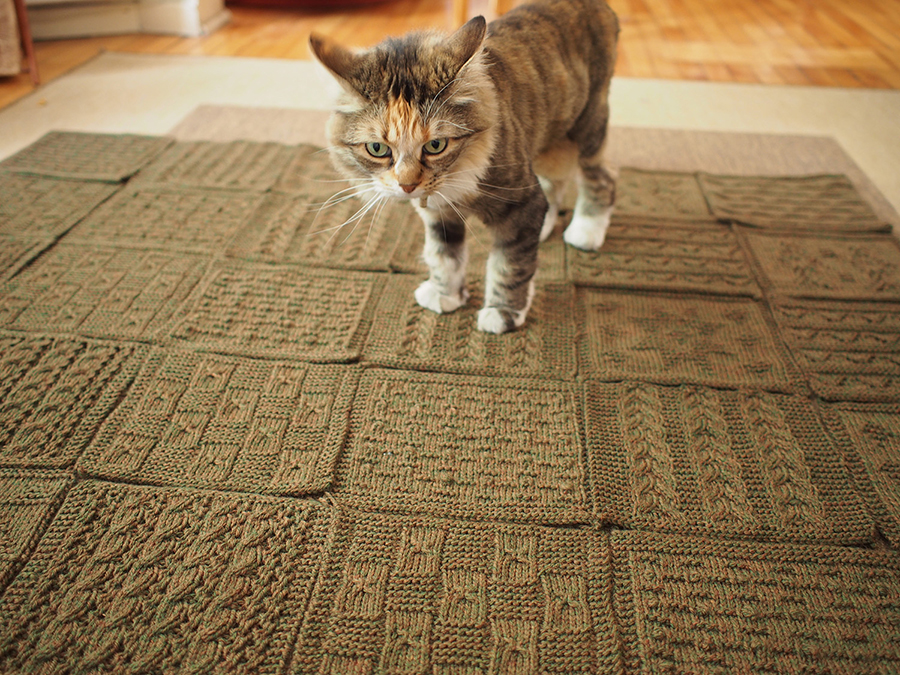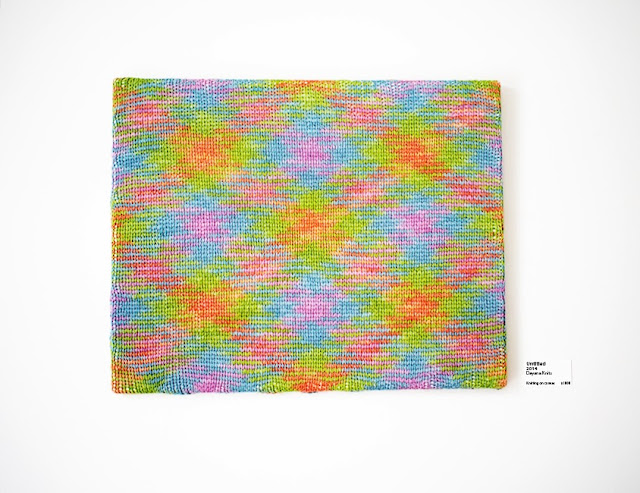I Take It All Back -- I Love Blocking Wires!
A few weeks ago, I posted about my favorite ways to block knits (defined: stretching your knitting out flat to make pieces look really nice). In that post, I inserted a snide little comment about how I really didn't like blocking wires... well, guess what came in the mail for review a week later? A sweetly packaged set of super-flexible blocking wires from Lazadas knitting accessories! Dayana likes when she must eat her words. :-)
Now, I was skeptical as my last experience with blocking wires was not fun. I had bought (from Knitpicks) a pack of long, straight, firm wires and had tried them out on a rectangular shawl. The point of blocking wires is to get a really nice flat edge, something you might want for shawls like this:
 |
| See Muchacha0Knits' lovely version of the Alpine Knit Scarf by Jane Sowerby, here. |
You see, if you use pins for a straight edge like that, you really have to pin every few millimeters to keep it so stick straight (which Muchacha0Knits managed beautifully actually, she didn't use wires). Usually what happens with conventional blocking is that you get a little scalloped edge where each pin pulls a little bit at the stretched knitting. You can't just stretch it less to avoid that either, because stretching lace out is absolutely essential to show off its beauty.
Another use for straight blocking wires is if you want border points of a shawl to be aligned perfectly, like seen here:
 |
| See Alianne's gorgeous version of Stripes and Torchon Lace by Jane Sowerby, here. |
So why didn't I like using the firm blocking wires? Well, I was under the impression that blocking wires saved you time. That is absolutely not true. Blocking wires need to be threaded carefully through the knitting so as not to damage the fabric. Also, the threading must be very consistent, especially for the long straight edges, or else you get scalloping as well. After all that careful threading, don't forget you STILL need to pin down the wires, just like a conventional block!
But I'm not one to give up on something. I'm hearing more and more great things from people who use blocking wires... especially the flexible kind. Yes, the new sets are completely flexible, and importantly don't snap, break or bend. Additionally, they can be used for both straight and very curved blocking shapes. After almost killing myself blocking my crescent shawl Sequin Stellaria... I was ready to try!
 |
| I can't believe I had enough pins to do this! And look at that sloppy crescent! Ugh. |
The pack from Lazadas came in a strong re-useable bag with snaps for storage. There were (4) 35 inch / 90 cm wires, (3) 70 inch / 180 cm wires, and a bag of T-pins.
I have two very important tips for you about these wires.
First, be careful when you open them. They're not going to whip out like a cobra snake, but they are definitely going to snap straight when you let go. Just unravel one "loop" at a time and you'll be fine.
Second, keep those wire twist-ties! You can definitely store these wires without them, but I can't guarantee that they won't come undone and either become a crazy mess in the bag or frighten the hell out of you when your pack becomes a Jack-In-The-Box.
I began by testing them for a straight edge project. Luckily, I had just finished a cute little test knit that used lace and drop stitches and needed some Very Serious Stretching.
Let me tell you right now: FLEXIBLE WIRES ARE SO MUCH EASIER TO THREAD! First, you can just bend the long wire towards you as you thread on your couch, in your bed, in the bath, whatever crazy thing you like to do! With straight ones you need to be in a special position, and you need to have that length of space around you. Second, it's much easier to loop wire through (either as a twirly whip stitch move or like a basting stitch, your choice) if you can bend it in your hand. Very satisfied with this step.
The points are VERY sharp. I was worried about this, but it turned out perfect for the mohair blend I was using. I could easily stab through without having to really think much about where the stitches were. However, if you are using a silk blend, please be very careful as you thread, as you will likely split stitches with the points. Sanding down the points is an option (much like a yarn needle has a blunt point).
Here I used 4 of the shorter wires: 2 for the side seams for maximum stretch, and two for the cardigan fronts in parallel. You can see I used conventional pins for the body and sleeve hems, as I didn't need them to be particularly straight for any reason, and honestly, that is way too much work. Even MY anal-retentiveness stops there.
After blocking, I found that I had really over-pleated the seams by the stretching, almost like I had ironed them down. I could see spaced of unevenly stretched parts where I had been lazy/sloppy with my threading. So people, if you want it to be perfect, take your time.
See my finished Catskill Cardi!
The next trial was the dreaded crescent shawl. I spent hours and hours pinning this baby out, it nearly killed me. Even worse, I used a yarn that had quite a bit of synthetics, and so the shawl lost all of its definition pretty fast, negating all of my work. Basically, it desperately needed a re-block, and this was going to be the day.
 |
| Torture By Pins |
I found that the longest wire sufficed for the interior curve, that was nice. But I had to use 2 wires to deal with the outer curve with all the lace points. I threaded it through 7 points in each flower motif... what a job! Once again, the curved wire made all the difference in making this part of the process more enjoyable.
After much trial and error, I learned the order you should do a shawl like this:
1. Pin out your inner crescent. That shouldn't take many pins, and you should let the wire do the work holding the perfect mathematical crescent shape. Man, that was a real beauty, something I could never do with pins.
2. Start by pinning out the center point of the center flower, then work radially left and right. I made the mistake of starting on the corner, and was way off in spacing by the time I was at the second half.
3. Finish by 'bending' each flower motif by pinning in between. It's really cool how the wire will bend the same way around every flower.
Voilà! She's back, and she looks mighty fine! If I had to do this again, it would be pretty fast, and I'd have more symmetrical flowers every time. Not bad... in fact, awesome! These flexible blocking wires are my new favorite toys!
TIP FOR PUTTING AWAY YOUR WIRES: Look carefully at the wires when you receive them. Do you see how the ends are twisted around the loop? It's very easy to do, and that is how you should store these. Twist each end around and you will see that it will remain closed without the twist-tie. But as I said before, add that twist-tie in at the end, just to make sure you're SAFE FROM HARM (lol, it's not that bad).
I would like to thank Astrid from Lazadas for taking the gamble of sending Dayana the Blocking Grouch these wires. I haven't tried other flexible sets, but this one was a pleasure to use. Visit the Lazadas webpage to buy a set! There are different choices, and you can even contact her for a custom length. Even better, shipping is $5 world-wide.
If you try flexible blocking wires out sometime, I'd love to know what you think! Here's an easy link to comment.
Related posts:
<<<<<>>>>>
Follow my blog by feed, e-mail, Bloglovin'




















These really sound ideal! Too bad I hadn't heard of them before I gave up and bought plain old straight wires a year ago. The difference in the shawl says it all. It was lovely before, but fantastic now.
ReplyDelete-- stashdragon
Oh, man, too bad! I'm actually surprised Knitpicks doesn't sell flexible wire sets by now... Thanks, I've been wearing it for 3 days now, points are starting to fade.... arghhh!
DeleteI have been learning so much from your blog and Facebook :) I haven't knit anything yet that needs blocking with wires, but I'm definitely interested in these bendy ones!
ReplyDeleteOoh, I'm glad you've been enjoying my posts! I'm glad you commented because I'm following you now. :) Laughed out loud when I read, "GOOD THING I’M NOT IN THE REAL OLYMPICS…"
DeleteWhat a wonderful, informative post! I learned so much about blocking with wires, I will definitely store this knowledge away for later. :-) I have never done this myself, but blocking with straight wires sounds like a horrible nightmare. So glad there is a better alternative out there!
ReplyDelete
ReplyDeleteWhat an interesting post, Dayana! I had never heard about these kinds of blocking wires before and they really sound ideal.
For many of the same reasons you mentioned I never really got into using the long, strait blocking wires. After reading this post I'll keep my eyes peeled for the flexible ones.
I got a set from Inspinkitty, during their shortage where they were waiting on sets to arrive. So I took advantage of a sale...this was a while ago. I actually looked at my set now and found that the points on the wires are wearing protectors so you can easily thread the wires through the knitting. Something I'd not noticed before!
ReplyDeleteFlexible wires for the win!
Thank you so much fro mentioning the wire protectors! This kit doesn't have them, but it would be great to include some removable ones perhaps? Interesting. I wonder if you could just dip them in wax or paraffin, too...
DeleteLove the look of these. I've made a lot of shawls recently and pinning out 50 billion points only to have each side uneven is rather disheartening! How do you think they would work for straight edges, would they be too bendy or would they be ok if pinned at intervals?
ReplyDeleteYes, fortunately they work really well for straight edges and don't bend at all when held straight. Actually the green cardi above was done along the straight side seams, you just pin the wires in place. Basically, these wires do it all!
DeleteOh yes of course, silly me! I was so taken with how beautifully your shawl turned out blocking with them that I somehow skipped over the straight edges on your cardi! I think a set of these wires is in my future :) Thanks for your reply!
DeleteExcellent review. This has helped me to decide to stock these in my shop in New Zealand. I love how the internet makes sharing knowledge so easy. Thanks.
ReplyDeletePs am only responding as anonymous as new at this and not sure how to select any of the other options! deborah@knitnstitch.co.nz
I'm glad you enjoyed the review! I almost want to knit a crescent shawl again just so I can use these again ASAP. Don't worry about the anonymous thing, it is all very confusing, I know. The way I do it is open accounts on Blogger, Wordpress, whatever it takes and use "OpenID" I believe -- but now I'm not even sure. If any of your customers want a new blog to follow with tons of ideas on how to modify knits, bring them my way! :)
DeleteThanks so much for this post. I'm going to try to DIY some wires like these, because truthfully $30 + $10 shipping and tax seems a bit pricey in my opinion. Not that there are any reasonably priced blocking wires out there at all...! If I fail, I'll buy these ones.
ReplyDeleteGreat post, its July 2015 and I'm just now seeing this. This has solidified my decision to purchase the flexible wires over the straights. Thank you again for your great review. I love how straight talking and plain you made it seem. Off to purchase myself a set. Thank you again!
ReplyDeleteI'm so glad you found the post. Because since then I've tried piano wire and a "flexible" blocking wire from Knit Pro that just kinks, and I am so happy to have my set!!!
DeleteI bought some based on your review and I love them! I just wish the ends were slightly tapered to make it easier to thread through, also that there was a stop you could put on the other end so you don't pull it through by mistake (I know me all too well and I haven't done it yet, but....)
ReplyDeleteBut they are fab and make blocking so much easier.
Dawn
Every time I use them I hem and haw over this! A taper would be great... but do I want it pointy or blunt?
DeleteI wonder if there is a good file that we could use to make our ends work the way we want. Also, now I am thinking of a putty or something for the other end... I feel like you come across perfect little stoppers on random items that could be stolen for this purpose. I will keep thinking!
Dayana
ReplyDeleteThanks for the notes. On the crescent shawl, along the neck edge, how did you hold the ends of the blocking wires in place? I enlarged the photo - it almost looks like they are fed into the burlap below.
And thanks for reading! 😍 The blocking wires were all pinned into the rug below, you sort of just corral them to the place you want and they'll rest against the pins. Use T-pins, because they really are strong.
Delete